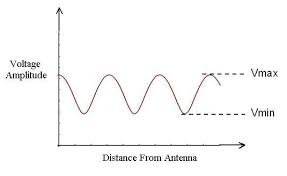The Standing Wave Ratio (SWR) is a measurement used to describe the efficiency and impedance matching of transmission lines, such as coaxial cables or antennas. It indicates how well the impedance of the transmission line matches the impedance of the connected load or antenna.

When an electrical signal travels along a transmission line, it encounters reflections due to impedance mismatches. These reflections can result in the formation of standing waves, which consist of points along the transmission line where the voltage and current vary in magnitude and phase. The SWR quantifies the amount of power reflected by the load or antenna compared to the power delivered to it.
The SWR is expressed as a ratio, typically ranging from 1:1 to infinity. A perfect impedance match, where all the power is delivered to the load or antenna without any reflections, results in an SWR of 1:1 (also referred to as VSWR or Voltage Standing Wave Ratio). An SWR of 1:1 indicates optimal performance and minimal power loss.
However, in practice, impedance mismatches are common, leading to reflections and a higher SWR. Higher SWR values, such as 1.5:1 or 2:1, indicate a less efficient impedance match and increased power loss due to reflections. An SWR of infinity (or an open circuit) or 0 (or a short circuit) indicates a complete impedance mismatch and a total reflection of power.
A high SWR can have various consequences, including reduced signal strength, degradation of transmission quality, and potential damage to equipment. It is desirable to minimize SWR through proper impedance matching techniques, such as using matching networks or adjusting antenna lengths.
SWR can be measured using specialized instruments called SWR meters or by using vector network analyzers (VNAs). These devices measure the amplitudes of voltage or current at different points along the transmission line and calculate the SWR based on the measured values.
In summary, the Standing Wave Ratio (SWR) is a measurement used to evaluate the impedance matching and efficiency of transmission lines. A lower SWR value indicates better impedance matching and reduced power loss due to reflections.
The Standing Wave Ratio (SWR) can be mathematically expressed using the following formula:
SWR = V_max / V_min
where:
- V_max is the maximum amplitude of voltage (or current) along the transmission line.
- V_min is the minimum amplitude of voltage (or current) along the transmission line.
In practice, the SWR is often determined based on voltage measurements. Therefore, V_max and V_min represent the maximum and minimum voltage amplitudes observed along the transmission line, respectively.
The SWR is a dimensionless quantity expressed as a ratio. A value of 1:1 indicates an ideal match (no reflections) and optimal performance, while higher values indicate increasing levels of impedance mismatch and power loss due to reflections.
It’s important to note that SWR can also be calculated using other quantities, such as power, by considering the square of voltage or current values. The fundamental principle remains the same: SWR quantifies the ratio of the maximum and minimum values of a specified parameter (voltage or current) along the transmission line.
Important Links